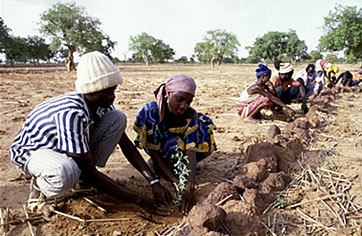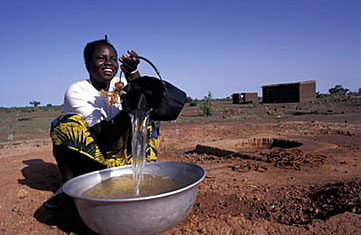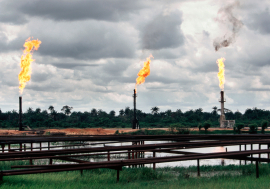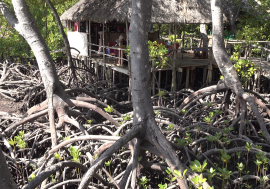Coping with less rain in Burkina Faso
 Planting trees along a stone line to prevent soil erosion from heavy downpours of rain.
Planting trees along a stone line to prevent soil erosion from heavy downpours of rain.The heat wave that started in March has not yet, two months later, given way to the first rainfall of the new farming season, except in a few isolated parts of Burkina Faso. Abel Raogo, a 60-year-old farmer in the village of Ipelcé, some 50 kilometres from the capital, has already finished sowing his fields. Now he waits for the rain.
“The good, generous years — when farming could begin in April thanks to early, plentiful and lasting rains — are long behind us,” he remarks, sitting in his field in the shade of a shea tree. “Forty years ago, we weren’t tormented by constant anxiety and uncertainty, worried about poor harvests, like we are today.”
Hamadou Tamboura farms and raises livestock near Sapouy, in a neighbouring province. He moved there five years ago from the arid Sahel region in Burkina’s north. “I decided to move to Sapouy to escape the hard conditions of the Sahel’s hostile environment and seriously degraded land,” he explained to Africa Renewal. But now his land in Sapouy has become exhausted and no longer produces enough.
Raogo and Tamboura toil in different areas. Each faces his own particular situation. But they are both aware that the conditions they confront are no longer what they once were. The two farmers have seen the reality of the changing weather, although they are not sure of the reasons. They do not ask for explanations of “climate change.” That concept features mainly in national and international intellectual debates. They do understand the immediate dangers represented by degrading soils, drying rivers and other changes in their environment — and they want urgent, concrete solutions to those problems.
 Drawing water in rural Burkina Faso: The government is helping villagers dig wells and build small water reservoirs to better utilize the country’s scarce water resources.
Drawing water in rural Burkina Faso: The government is helping villagers dig wells and build small water reservoirs to better utilize the country’s scarce water resources.Vulnerability
Burkina’s economy is based mainly on agriculture, which provides livelihoods for 80 per cent of the population. Natural constraints, such as degraded soils, recurrent droughts, deforestation and spreading deserts, have a major impact. They combine to make people’s lives more vulnerable.
Over the past four decades, Burkina has experienced frequent extremes of climate. Drought in the 1970s caused a serious famine, which cost numerous lives and major livestock losses. Although famine has been less severe since then, it remains a frequent spectre in parts of the country.
Over the decades, Burkina’s desert areas have been spreading, a process known as “desertification.” Scientists find it difficult to separate desertification from climate change. There is evidence that desertification influences local climate patterns, while climate variations in turn affect the process of desertification.
In a 2006 study, the National Council for Environment and Sustainable Development, an inter-ministerial coordinating body that also includes independent experts and civil society representatives, identified four sectors that are most vulnerable to climate change: water, agriculture, stock raising and forestry.
Lower rainfall and higher temperatures have contributed to the silting and evaporation of lakes and rivers and a long-term decline in the capacity of water reservoirs. In the Central Plateau region, according to government figures, three-quarters of the 84 dams and reservoirs are silted and require rehabilitation. Farmers report that some dams and reservoirs no longer hold enough water during the dry season to enable them to produce crops.
Albert Bouda grows vegetables in fields irrigated by the Goué dam, near Ouagadougou. Now, to keep on farming, he told Africa Renewal, “we have to dig wells to get enough water for our crops.”
Higher temperatures lead to more evaporation from water bodies, and also degrade the quality of soil, contribute to the spread from the north of certain agricultural pests such as locusts, lower crop yields and reduce biodiversity. Agricultural experts estimate that 30 per cent of Burkina’s land suffers from serious degradation.
The eastern and southwestern parts of the country, which are rich in natural resources and generally have more favourable weather, are increasingly hit by high temperatures and pockets of drought. Human activities — excessive cutting of trees, overgrazing by livestock and more intensive farming — also contribute to environmental deterioration.
In the east, “we see the start of growing pressure on the land, especially around strategic resources such as protected conservation areas, rivers and lakes,” notes Antoinette Ouédraogo, president of a women’s development association and a member of a national climate change experts’ group. Those pressures, she told Africa Renewal, include the uncontrolled clearing of land, poaching of wildlife and migration of livestock, as herders from the north search for new pastures. Such environmentally harmful practices worsen the impact of climate change.
Ironically, the north, which usually has Burkina’s lowest average rainfall levels, has in recent years sometimes experienced unexpectedly heavy rains. In August 2006, for example, a downpour in Oudalan province caused serious flooding, with widespread property damage. Meanwhile, sandstorms, which normally hit only the northern parts of the country, now affect other regions as well.
Adaptation plan
In 1992, Burkina was one of the early signers of the United Nations Framework Convention on Climate Change, which was negotiated that same year. At the end of 2006, an interdisciplinary group of experts, working under the authority of the Ministry of the Environment, drew up a National Adaptation Plan of Action (NAPA), designed to initiate concrete responses to the challenges of climate change. The plan has been adopted by the government.
Drafted in consultation with civil society organizations and community representatives, the NAPA is intended to identify immediate needs and projects to help local communities confront the adverse effects of climate change.
“Even though the situation in Burkina is not today catastrophic,” explains Mamadou Honadia, a member of the NAPA coordinating committee and Burkina’s former national focal point for the UN convention, “there are grounds for concern and to take action to mobilize the necessary financial and human resources to address the impact of this phenomenon.”
As it is conceived, the NAPA will be used not only to counter the current negative impacts of climate change, but also to anticipate their consequences and the rise of new threats. National experts expect average temperatures to increase by 0.8 per cent by 2025 and by 1.7 per cent by 2050. Meanwhile, average annual rainfall could decline by 3.4 per cent by 2025 and by 7.3 per cent by 2050.
“Lower rainfall, combined with higher temperatures, will have negative repercussions on overall agricultural production and on the vegetation cover because of diminished surface and underground water resources,” says the plan. “Satisfying the water needs of people, livestock and crops will be difficult, given that water capacities are weak.”
Because the challenges are huge and the available resources are limited, observes the plan, successfully countering the adverse impacts of climate change will require the involvement of all national actors, from the government down to local communities. It will also require adequate assistance from the international community, to support the country’s own efforts.
Reservoirs, trees and seeds
Whether it is against the impact of climate change or environmental degradation more generally, the government has already initiated action on a variety of fronts. In his annual “state of the nation” address to parliament in late March, then Prime Minister Paramanga Ernest Yonli cited a number of actions over the past year alone:
- Developing small-scale irrigation projects on 26,000 hectares of land and training thousands of farmers in irrigation techniques and water management, as part of a decade-long plan to promote irrigated farming
- Starting or completing construction of more than two dozen medium-sized dams and water reservoirs
- “Adapting to climate change” by extending an experimental project, known as the Saaga programme, to seed clouds in the arid Sahelian zones
- Producing more than 8 mn tree seedlings to replant 13,000 hectares of land
- Building more than 1,660 kilometres of “living hedges” as wind breaks
- Rehabilitating nearly 4,000 hectares of degraded land
- Fixing sand dunes over nearly 350 hectares in the Sahel
- Encouraging farmers to adopt improved and hardy new seed varieties that require less water, such as high-yielding cassava and the New Rice for Africa (Nerica).
Many civil society groups and non-governmental organizations (NGOs) are active around environmental issues in Burkina. They help train farmers to conserve water, topsoil and vegetation and introduce practices that both preserve the environment and increase yields.
According to Henriette Ouédraogo, president of the Ragussi Association, a group of 60 women shea butter producers active in the central region, her group seeks to raise women’s awareness of the risks of cutting trees and the hazards of using certain kinds of chemical pesticides and fertilizers. The association also promotes the conservation of shea trees and other plants that can provide farmers with additional sources of income.
Dialogue and partnerships
To share experiences and help coordinate their areas of work, many of these environmental groups have formed the Network of NGOs and Associations for the Protection of the Environment (ROAPE). Its coordinator, Paul Bayili, believes that civil society has a key role to play in raising public awareness of climate change and in developing responses. “ROAPE has set itself the goal of popularizing the concept, with government support,” Mr. Bayili told Africa Renewal.
In March, the ROAPE organized a regional workshop on climate change with the aim of defining a strategy to counter its negative effects. Participants recognized the importance of raising the awareness not only of the general public, but also of elected officials, decision-makers and managers of urban zones and forest preserves.
According to Mr. Honadia, of the NAPA coordinating committee, partnerships with the government and such NGOs, as well as with technical experts, rural producers and donor agencies, are essential for confronting Burkina’s environmental challenges.
“Dialogue is needed,” he told Africa Renewal. Through building partnerships, it will be possible to develop projects that benefit from on-the-ground experience and involve all actors. In that way, no one will be pushed to the margins, and “everyone can agree to move forward.”












